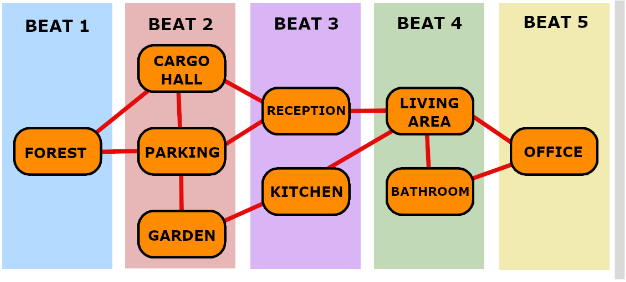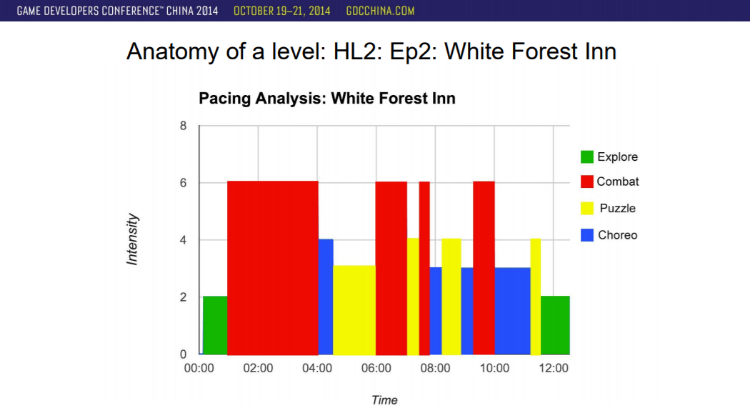Pacing Diagram
also known as:
Classification
#method #medium/diagram #medium/visual #tools/non-digital #tools/digital #roles/designer #process/planning #process/designing
Intent
- Structure your level with a story narrative that maintains player engagement.
- Achieve a balance between intense gameplay sequences and exploration to maintain player interest.
- Effectively communicate your creative vision with your team.
Problem
General
- Planning a level to align with a story narrative, such as the three-act structure, is essential to maintain your vision throughout production and connect it with other levels on a broader scale.
- Players may feel overwhelmed if a scene is too densely packed, or they may lose interest when nothing significant is happening.
- Ensuring that the tempo and rhythm of your game are fitting with the game and the player.
- Drawing parallels to music: An interesting music piece changes over time.
Specific
- Creating a level with a boss fight and thrusting players directly into the battle can lead to discomfort, frustration, or anxiety.
- Maintaining tension at a constant level without variation can result in player boredom.
- Linearly increasing pacing may become too predictable.
Approach/ Solution
- Utilize the three-act structure and document it on a timeline.
- First Act: The setup of the plot.
- Second Act: The confrontation.
- Third Act: The resolution.
 (Source: World of Level Design)
(Source: World of Level Design)
- Pacing consists of three core elements:
- Intensity (combat is high intensity, exploration or puzzles are low intensity).
- Variety (monotone levels are boring).
- Time (if a level takes too long, players may not finish it).
- Think of pacing as a music piece: It includes elements like
- Rhythm (the game’s tempo).
- Flow/Melody (variation in pacing).
- Harmony (how gameplay and story elements work together).
- Form (emphasis on big moments).
- Timbre (the unique quality of gameplay mechanics).
- Dynamics (intensity, enemy numbers, aggression).
- Texture (complexity of gameplay).
- Gameplay Beats: Main events and activities in your level that maintain player interest.
Application
Input
- An idea of the narrative in your head.
- Knowledge about the level’s story structure (e.g., three acts) and gameplay beats.
- Pen and paper or a digital tool to visualize your diagram.
Application
- Create a visual level timeline by documenting the story structure on a timeline and adding gameplay beats. Use color-coding for specific recurring patterns in your level (e.g., tutorials in green). Add hard gates (Def.: Narrative sections that have to be triggered by the player to further advance in the level) to further structure your level.
 (Source: World of Level Design)
(Source: World of Level Design)
 (Source: World of Level Design)
(Source: World of Level Design)
- Represent your pacing on a line stretching across your story structure (three acts) on a timeline.
- Alternatively, represent pacing in boxes:
 (Source: TychoBolt (K., Alex) 2020 - In Pursuit of Better Levels)
(Source: TychoBolt (K., Alex) 2020 - In Pursuit of Better Levels)
- Strive for non-monotonic pacing that keeps player attention while allowing for smooth level progression without losing tension.
- Vary your pacing; more pronounced differences between high and low pacing can create a dynamic and engaging experience or be overwhelming.
- Remember that every player has their own pace, unlike movies where pacing is linear and consistent for all viewers.
- Expect a fair amount of trial and error. Experiment with various approaches, discuss, and revise accordingly.
- Ensure that the pacing matches the overall tone of your game and aligns with other levels, considering both broad and specific connections.
Non-linear Pacing Diagrams
- Your level flow doesn’t have to be linear; it can include alternative routes based on player decisions or specific trigger points.
-
To control the overall pacing, divide the level areas into beats. Define and combine several linear pacing diagrams if necessary.
 (Source: TychoBolt (K., Alex) 2020 - In Pursuit of Better Levels)
(Source: TychoBolt (K., Alex) 2020 - In Pursuit of Better Levels) - In an open world, consider restricting areas to players, for example entry areas. This helps directing the pacing for the player, at least to a certain amount.
X/Y axis Pacing Diagram
- Plot two variables against each other on an x and y axis to analyze their connection and how they work together
- For example, analyze how intense the gameplay becomes over time
-
Sort the narrative in categories and analyze when these categories appear in the narrative over time and how high their intensity is
 (Plotting the categories “Explore”, “Combat”, “Puzzle” and “Choreo” against each other for the White Forest Inn encounter in “Half-Life 2: Episode Two”. Source: link)
(Plotting the categories “Explore”, “Combat”, “Puzzle” and “Choreo” against each other for the White Forest Inn encounter in “Half-Life 2: Episode Two”. Source: link)
When to use this method
- During the design phase when crafting your level.
- Provides a solid foundation for further level details and is beneficial to have established in advance.
Relevant Roles using this model
Output
- A Diagram or Graph that clearly illustrates the pacing of your level.
- A Timeline may also be used to represent a pacing diagram. See the example of an x/y axis pacing diagram.
Relevancy in the following Processes:
- Game Development planning and designing step
- Combat Design utilizes a pacing diagram to define when a combat sequence will take place.
- Gamespace Prototyping when creating charts (second step) and drawing a map (third step)
- May help Iterative Map Design to define pacing in the level
Applicability
- The output serves as an effective means of communicating your vision to the team.
- Easy to understand by everyone, fostering clarity in the level design process.
- Suitable for both agile and waterfall approaches, as it provides a fixed document for reference.
- Excellent for iteration but may need to be finalized once level building begins.
- Requires prior knowledge of gameplay beats to align with pacing.
- Complexities arise when considering alternate routes; non-linear pacing can be challenging to implement.
Pros and Cons
Pros:
- Easy to understand
- Fixed document that can be referenced to at any point
- Clear language that supports the process of level designing
- Quick work with a lot of impact
Cons:
- Might be too abstract if you don’t define the gameplay beats beforehand
- Doesn’t include the player’s individual behavior and might not work out in the end (it’s only on paper anyways)
- It’s difficult to set pacing in an open world
Relations with other methods
- Behavior Diagram
- Reward Schedule
- Nintendo Power Method analyzes the pacing
- Symbols and Visual Language
- Game Design Document
- Behavior Diagram
Examples
Relevant Tools
- Some Digital Diagram Tools
- Non-digital Design Tools like pen and paper
- Communication Tools like teams/slack
- Digital Collection Tools or folder structure to save your diagrams in
Relevant Literature
Level Design - Pacing Gameplay Beats
Music Reference: Examining Game Pace - How Single Player Levels tick
TychoBolt (K., Alex) 2020 - In Pursuit of Better Levels
Totten 2019 - An Architectural Approach of Level Design
Level Design Book, Pacing chapter
...
 (Source:
(Source:  (Source:
(Source: